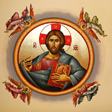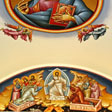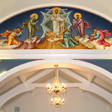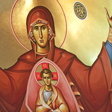Other Shreveport Articles
Cultural Preservation: Keeping the Flame Burning for Future Generations
Seasons and Cycles — Festivals and Rituals Mark Life's Rhythms
Of Hand and Heart: Handwork Connects Family and Community

Shreveport's Greek Community: Cultural Treasure Spanning Generations and an Ocean
By Laura Marcus Green
A Language of Faith: Greek Orthodox Iconography
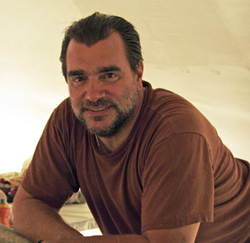
St. George's newest icons and icon murals are the work of Tom Clark, a Greek-American iconographer based near Athens who paints Greek Byzantine icons on commission for Orthodox churches throughout the United States. Tom grew up in Chicago, where he was a member of a Greek Orthodox congregation. Although his father and brother were painters, he was never particularly drawn to the art form. That changed in 1984, when Tom was traveling with his wife in Greece. Walking in a little town, they passed an icon shop where a young man was at work. Tom recalls feeling pulled into the shop, where he talked to the young painter. Captivated by the art form, he embarked on a five-year apprenticeship with the owner of the shop, the well-known Greek icon painter, Kostas Tsilsavides of Thessaloniki. Thus began a profession that has taken Tom around the world to perpetuate a centuries-old tradition.
Tom and his family live outside of Athens, Greece, but almost all of his work is in the United States, with an occasional project in Europe. Two of their sons are following in Tom's footsteps, becoming artists. They are learning to create icons in their original medium: mosaics. Occasionally, Tom's sons accompany him to his project sites and work with him as assistants. Tom paints the icon murals in his home studio in Greece and transports the canvases to their destinations, where he installs them and adds final details. To complete his work and visit with church personnel about upcoming projects, Tom often spends months at a time in the U.S., traveling throughout the country. He often stays at the churches where he is woking, so that he can paint whenever he likes.
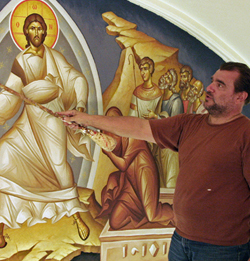
When Tom began work at St. George in Shreveport, its interior was completely white. All of the church's icons hung on the walls. Some of them have been there for decades and are understandably cherished by congregants who have seen these icons every Sunday throughout their lives. Tom was aware of the congregation's reticence about the installation of his icon murals, even though they had desired and planned for the building's renovation. It was a big change to their historic church. The older icons remain an important focal point of the church, along with a more contemporary set of Greek icons that show scenes from the Bible. As he was completing his work, Tom looked around the church and marveled, "It's alive."
Alluding to the church's icons, Father Brendan Pelphrey explains that the church's material culture traditions, while aesthetically moving, are not considered "art," per se, but are rather
a vehicle for participation. We don't refer to it as art because iconography was a means of transmitting the faith. You have to remember that most people could not read until last century. So iconography was the way to convey stories—stories about Moses or Abraham or about Jesus or the Disciples. These paintings, we are quite sure, date from the very first century. The iconography is not decoration, it's integral to the worship.
Tom describes icon painting as a language. In Greek, the word for iconography is ideographos, meaning "holy writing." Throughout the world there are several styles of Orthodox icons, including Greek Byzantine (the tradition in which Tom works), Russian, and Ethiopian. A trained eye can discern among the various styles. Father Brendan and Tom point out that while stylistic variations may reflect differences in climate or topography, the fundamental style elements of each icon tradition are based on more interior qualities. In Ethiopian icons, for example, the ears are often depicted as larger than the mouth. This conveys the idea that it is best to listen and learn.
These variations notwithstanding, some aspects of the icons remain fixed, regardless of the cultural tradition in which they appear. Elaborating on the concept that icons are a language, Father Brendan and Tom explain that the symbolism in the icons is prescribed. Father Brendan expands on this idea:
The icons were transmitting theological statements. That's why they don't vary. Our iconographers don't make up anything that they paint. You can't decide, 'Oh, I'll just paint the sky blue.' There would be a form that you follow. And it would have a distinct meaning. So if I look at the colors of the robes, they have meaning. I can take you to the different icons and show you why this one is wearing red with blue over it. The hand gestures all have meaning. So [do] the scrolls that they carry or books that they're holding—maybe they're holding a cross, which means they're a martyr.
When called upon to give presentations about icon painting, Father Brendan tries to dispel the widely-held but incorrect belief that icon painters do not know how to paint perspective. This notion is based on the icons' seemingly flat appearance. An artist himself, Father Brendan explains that in fact the icon painters are very skilled. They are not trying to create exact or biologically correct representations of the saints. Tom gives the example of the icon depicting the Resurrection, when Jesus not only rose from the dead, but he also pulled others from their graves, including Adam and Eve. This scene is one of the icon murals Tom painted for the interior of St. George's dome. The icon shows Jesus pulling Adam and Eve from their graves by their wrists. Tom points out that It would not make anatomical sense to pull someone by his or her wrists. Rather, this scene conveys the idea of Christ's power.
On the question of spiritual versus biological representation, Father Brendan explains that in the Orthodox tradition, the idea is that the human body comes and goes. However, it is the essence of the saints that the iconographers portray in their work. In this way, people can "read" the icons and connect with the saints or other holy figures through their stories and their human qualities. He comments,
In iconography, you're depicting how a person is spiritually. What did they teach? Was it patience? Or was it endurance through torture, maybe, as a martyr? Or was it wisdom? The language is depicting that, the spiritual essence of a person. Sometimes their physical appearance is passed down as tradition. So you can look at icons of Peter or Paul or James or John from any century and you'll identify them right away. Because they always look the same.
When embarking a new project, Tom consults at least six different versions of the icon he will be painting, including Ethiopian, Russian, and Greek Byzantine examples. Studying these icons, he looks for the common denominators, motifs that must be essential if they are in all of the versions. He does an initial sketch that becomes a first draft, letting the artistic process inform his work. In fact, this is how he first began learning to paint icons. At the outset of his apprenticeship, Tom's mentor told him to fill up a sketchbook before he embarked on painting.
Although the main elements of the icons are established, there is still room for personal style and interpretation. Tom is attuned to the emotional tone of the icons he paints. At St. George Greek Orthodox Church in Shreveport, he painted the Christ Pantokrator or "Ruler of the Universe" inside the dome above the sanctuary. This icon shows Christ giving humankind the Book of Life. Tom says that people have observed that in his Pantokrator icon, Jesus looks serious. Tom explains that this icon represents an important moment, when Jesus is handing people a sense of accountability for their actions. He is giving them guidelines for how to conduct themselves in the world. So this is indeed a solemn moment.
Inside St. George's dome, on either side of the Pantokrator, are icons of the Resurrection and the Transfiguration. In corner spaces below the dome are icons of the four Gospels: Matthew, Mark, Luke, and John. Tom also painted all of the icons that are set in the gateway, or altar screen.
Another icon that Tom painted for St. George is "The Sign" Platytera ("Encompassing the Heavens"), which depicts Christ in Mary's womb. This icon is in the church's altar area, behind the gateway. Reflecting on his depiction of Mary, referred to as the Theotokos, Tom says that he tried to represent her as compassionate, loving, and strong. This took some thought on his part. In the icon, her arms are uplifted, seemingly in a loving or supportive embrace, but one that is strong enough to care for people, to hold them. So he strove to balance Mary's gentle, loving energy with her strength.
Tom's passion for icon painting is a natural expression of the Orthodox faith in which he was raised. Working in his studio or atop a towering scaffolding may seem a solitary occupation. Yet, Tom never feels alone when he is painting, observing that he is in the company of the saints, whom he considers his big brothers, people who were alive a long time ago. He considers his ability a gift that has been given to him, one he is still developing. In his work, he likes being stretched to new levels. About the profession that has spanned twenty years to date, Tom says, "I feel like I'm just scratching the surface of what I'm doing. Experience is the best teacher of all."
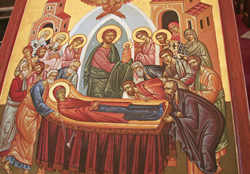
Just inside St. George's inner or middle section, an icon on a wooden stand greets congregants as they enter. While many of St. George's icons remain in permanent locations in the church throughout the year, the stand holds a rotating display that corresponds with the Orthodox calendar of saints' days and other holy occasions. In addition to the icon at the entry to the sanctuary, other elements of Orthodox worship cycle with the seasons, cueing the congregation to the time of year and its meaning in their lives. Greek Orthodox worship is realized through multiple senses, including sight, sound, and taste. For example, the musical scales sung by the church choir each week synchronize with the Orthodox calendar. Ritual foods shared during weekly services and at special times of the year or in people's lives are part of the Orthodox tradition.
St. George's altar cloth sets also correspond to particular times of the year. These sets have all been hand embroidered and sewn by women in the congregation over the years. Father Brendan believes that some of the church's historic cloths may pre-date World War II. After his arrival at St. George, he found some of the older sets tucked away in boxes for safekeeping, no longer in use. He took them out, saying "This is far too beautiful to just hide." People in the congregation responded, "Well, they're old." Father Brendan pointed out, "Yes, but that's part of the beauty of it, the Church is old." Some of the older pieces were made so long ago, no-one knows any longer who made them. Father Brendan is sure that they were made by congregation members. Although some of the historic altar cloth sets show signs of use over the years, their beauty shines through, a testament to the traditional knowledge that earlier Greek settlers brought from home.


